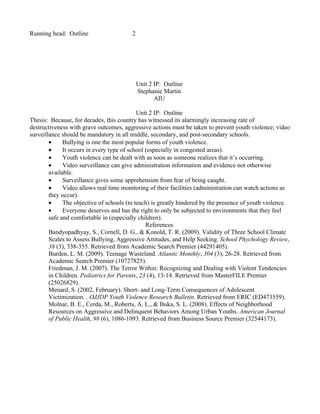SMartin_IP2
- 1. Running head: Outline 2 Unit 2 IP: Outline Stephanie Martin AIU Unit 2 IP: Outline Thesis: Because, for decades, this country has witnessed its alarmingly increasing rate of destructiveness with grave outcomes, aggressive actions must be taken to prevent youth violence; video surveillance should be mandatory in all middle, secondary, and post-secondary schools. âĒ Bullying is one the most popular forms of youth violence. âĒ It occurs in every type of school (especially in congested areas). âĒ Youth violence can be dealt with as soon as someone realizes that itâs occurring. âĒ Video surveillance can give administration information and evidence not otherwise available. âĒ Surveillance gives some apprehension from fear of being caught. âĒ Video allows real time monitoring of their facilities (administration can watch actions as they occur). âĒ The objective of schools (to teach) is greatly hindered by the presence of youth violence. âĒ Everyone deserves and has the right to only be subjected to environments that they feel safe and comfortable in (especially children). References Bandyopadhyay, S., Cornell, D. G., & Konold, T. R. (2009). Validity of Three School Climate Scales to Assess Bullying, Aggressive Attitudes, and Help Seeking. School Phychology Review, 38 (3), 338-355. Retrieved from Academic Search Premier (44291405). Burden, L. M. (2009). Teenage Wasteland. Atlantic Monthly, 304 (3), 26-28. Retrieved from Academic Search Premier (10727825). Friedman, J. M. (2007). The Terror Within: Recognizing and Dealing with Violent Tendencies in Children. Pediatrics for Parents, 23 (4), 13-14. Retrieved from MasterFILE Premier (25026829). Menard, S. (2002, February). Short- and Long-Term Consequences of Adolescent Victimization. . OJJDP Youth Violence Research Bulletin. Retrieved from ERIC (ED473559). Molnar, B. E., Cerda, M., Roberts, A. L., & Buka, S. L. (2008). Effects of Neighborhood Resources on Aggressive and Delinquent Behaviors Among Urban Youths. American Journal of Public Health, 98 (6), 1086-1093. Retrieved from Business Source Premier (32544173).

